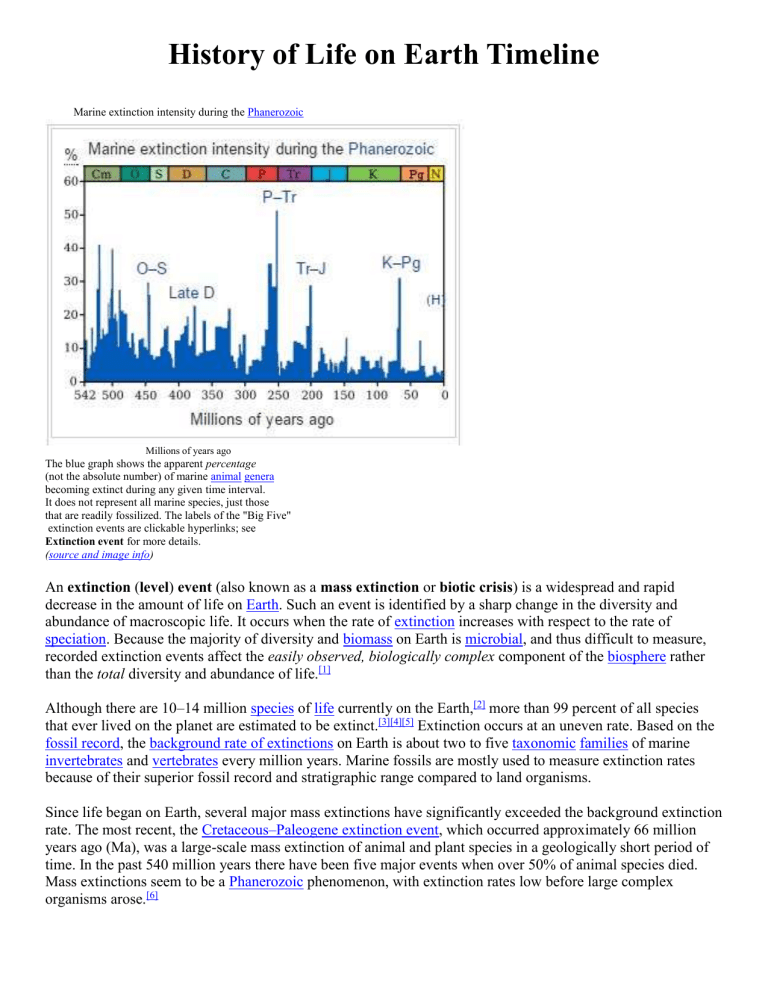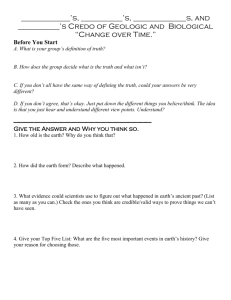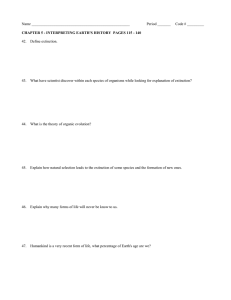Timeline of History of Life on Earth Lab Activity
advertisement

History of Life on Earth Timeline Marine extinction intensity during the Phanerozoic Millions of years ago The blue graph shows the apparent percentage (not the absolute number) of marine animal genera becoming extinct during any given time interval. It does not represent all marine species, just those that are readily fossilized. The labels of the "Big Five" extinction events are clickable hyperlinks; see Extinction event for more details. (source and image info) An extinction (level) event (also known as a mass extinction or biotic crisis) is a widespread and rapid decrease in the amount of life on Earth. Such an event is identified by a sharp change in the diversity and abundance of macroscopic life. It occurs when the rate of extinction increases with respect to the rate of speciation. Because the majority of diversity and biomass on Earth is microbial, and thus difficult to measure, recorded extinction events affect the easily observed, biologically complex component of the biosphere rather than the total diversity and abundance of life.[1] Although there are 10–14 million species of life currently on the Earth,[2] more than 99 percent of all species that ever lived on the planet are estimated to be extinct.[3][4][5] Extinction occurs at an uneven rate. Based on the fossil record, the background rate of extinctions on Earth is about two to five taxonomic families of marine invertebrates and vertebrates every million years. Marine fossils are mostly used to measure extinction rates because of their superior fossil record and stratigraphic range compared to land organisms. Since life began on Earth, several major mass extinctions have significantly exceeded the background extinction rate. The most recent, the Cretaceous–Paleogene extinction event, which occurred approximately 66 million years ago (Ma), was a large-scale mass extinction of animal and plant species in a geologically short period of time. In the past 540 million years there have been five major events when over 50% of animal species died. Mass extinctions seem to be a Phanerozoic phenomenon, with extinction rates low before large complex organisms arose.[6] Estimates of the number of major mass extinctions in the last 540 million years range from as few as five to more than twenty. These differences stem from the threshold chosen for describing an extinction event as "major", and the data chosen to measure past diversity. The Great Oxygenation Event (GOE), also called the Oxygen Catastrophe, Oxygen Crisis, Oxygen Holocaust, Oxygen Revolution, or Great Oxidation, was the biologically induced appearance of dioxygen (O2) in Earth's atmosphere. Geological, isotopic, and chemical evidence suggest that this major environmental change happened around 2.3 billion years ago (2.3 Ga).[2] Cyanobacteria, which appeared about 200 million years before the GOE,[3] began producing oxygen by photosynthesis. Before the GOE, any free oxygen they produced was chemically captured by dissolved iron, were it settled out of solution as iron oxides or organic matter. The GOE was the point when these oxygen sinks became saturated and could not capture all of the oxygen that was produced by cyanobacterial photosynthesis. After the GOE, the excess free oxygen started to accumulate in the atmosphere. Free oxygen is toxic to obligate anaerobic organisms, and the rising concentrations may have wiped out most of the Earth's anaerobic inhabitants at the time. Cyanobacteria were therefore responsible for one of the most significant extinction events in Earth's history. Additionally, the free oxygen reacted with atmospheric methane, a greenhouse gas, greatly reducing its concentration and triggering the Huronian glaciation, possibly the longest snowball Earth episode in the Earth's history.[4] Eventually, aerobic organisms began to evolve, consuming oxygen and bringing about an equilibrium in its availability. Free oxygen has been an important constituent of the atmosphere ever since.[4] Event in the fossil record Years ago Earth Forms Simple cells appear Cyanobacteria appear 4.6 Ba 3.6 Ba 3.4 Ba 0B 1B .2B 0cm 50cm 10cm Great Oxygenation Event Eukaryotes appear 2.3 Ba 1.1B 55cm .3 15cm Sexual reproduction arises Multicellular life appears 1st animals appear Bilaterians appears 1.2 Ba .8B 40cm 1 Ba .2B 10cm 600 Ma 550 Ma .4B .05B 20cm 2.5cm 500 Ma 475 Ma 450-440 Ma .05B .025B .025B 2.5cm 1.25cm 1.25cm 400 Ma .05B 2.5cm 375-360 Ma .04B 2.0cm 60-70% of all species become extinct. 360 Ma 300 Ma 251.4 Ma 0B .06B .0486B 0cm 3.0cm 2.43cm Land/water lifestyle Lay eggs out of water ~96% of marine organisms and 70% of terrestrial organisms extinct. Mammals appear 4. Triassic-Jurassic extinction event Birds appear Flowering plants appear 5. CretaceousPaleogene extinction event 200 Ma 200 Ma .0514B 0B 2.57cm 0cm 150 Ma 130 Ma .05B .02B 2.5cm 1.0cm Descended from dinosaurs Most plant forms we see today are Angiosperms. 66 Ma .064B 3.2cm Primates appear Hominidae appears 60 Ma 20 Ma .006B .04B .3cm 1.0cm Genus Homo appears 2.5 Ma .0175B .875cm Anatomically modern humans appear 250000 Ya to the present .00225B .1125cm Dinosaurs become extinct, except for the descendant birds, as do 75% of other species. Monkeys, etc. Ancestors of the Great Apes (chimpanzees, gorillas, and Orangutans) appear Direct ancestors of modern humans evolve in Africa Modern humans appear and colonize the Earth Fish appear Land plants appear 1. Ordovician-Silurian extinction event Insects & Seeds appear 2. Late Devonian extinction event Amphibians appear Reptiles appear 3. Permian-Triassic extinction event 2 Ba Interval in years Scale distance Description The Hadean Era Prokaryotes (anaerobes) Great Oxygenation Event: Many strict anaerobes perish, Takes ~ 1B years. Biogenic O2 begins to collect in the atmosphere. Cells with membranebound organelles First animals with a head end and a tail end. 60-70% of all species become extinct. 75% of all species become extinct. Event in the fossil record Years ago Earth Forms Simple cells appear Cyanobacteria appear Great Oxygenation Event Eukaryotes appear 4.6 Ba 3.6 Ba 3.4 Ba 2.3 Ba Sexual reproduction arises Multicellular life appears 1st animals appear Bilaterians appears 1.2 Ba Fish appear Land plants appear 1. Ordovician-Silurian extinction event Insects & Seeds appear 2. Late Devonian extinction event Amphibians appear Reptiles appear 3. Permian-Triassic extinction event 2 Ba Interval in years Scale distance Description The Hadean Era Prokaryotes (anaerobes) Biogenic O2 begins to collect in the atmosphere. Cells with membranebound organelles 1 Ba 600 Ma 550 Ma 500 Ma 475 Ma 450-440 Ma First animals with an obvious head end and a tail end. 60-70% of all species become extinct. 400 Ma 375-360 Ma 60-70% of all species become extinct. 360 Ma 300 Ma 251.4 Ma Land/water lifestyle Lay eggs out of water ~96% of marine organisms and 70% of terrestrial organisms extinct. Mammals appear 4. Triassic-Jurassic extinction event Birds appear Flowering plants appear 5. CretaceousPaleogene extinction event 200 Ma 200 Ma Primates appear Hominidae appears 60 Ma 20 Ma Genus Homo appears 2.5 Ma Anatomically modern humans appear 250000 Ya to the present 75% of all species become extinct. 150 Ma 130 Ma Descended from dinosaurs Most plant forms we see today are Angiosperms. 66 Ma Dinosaurs become extinct, except for the descendant birds, as do 75% of other species. Monkeys, etc. Ancestors of the Great Apes (chimpanzees, gorillas, and Orangutans) appear Direct ancestors of modern humans evolve in Africa Modern humans appear and colonize the Earth Timeline of Life History on Earth NGSS: MS-LS4-1. Analyze and interpret data for patterns in the fossil record that document the existence, diversity, extinction, and change of life forms throughout the history of life on Earth under the assumption that natural laws operate today as in the past. Objective: SWBAT complete a timeline of the history of life on Earth and relate the major changes in life to events in earth history. Materials: 1-2.5m length of adding machine tape, meterstick, ruler, calculator Methods: 1. Calculate the interval in billions of years between events in the history of life on Earth and record in the data table. 2. Calculate the scale distance for each event and record in the data table. 3. Place each event at the correct scale distance on your timeline. 4. Answer the analysis questions using the results from the activity. Answer using complete sentences. 5. Write a conclusion utilizing the C.E.R model as shown. Calculations: Scale= 50cm 1B years Interval in Billions of years= previous event - next event 1000000000 Scale distance= scale time interval Analysis: 1. Based on the timeline you completed, how have the five mass extinctions in Earth’s history affected the evolution of life on our planet? 2. Each of the five mass extinction events were responsible for eliminating greater than 60% of the life forms that existed at that time. How can we use this to explain what happened to life after these extinction events? 3. The vast majority of life on Earth today requires oxygen to survive. What event in earth history provided the oxygen that these organisms require? 4. These dates and events are determined by careful examination of the fossil record. How can we be sure that the dinosaurs actually went extinct in the Cretaceous-Paleogene extinction event? What would provide evidence that they survived beyond that event? 5. What happened to the first oxygen that was produced by the Cyanobacteria? 6. What is the definition of Phanerozoic? Conclusion: Claim-Evidence-Reasoning model





